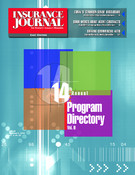CONNECTICUT
Work-Related Deaths: The number of deaths in Connecticut due to work-related injuries increased by 50 percent last year, rising from 36 to 54, according to a state report. Connecticut is one of 27 states to have reported an increase in workplace fatalities in 2004, according to the report that was issued by the state Department of Labor. Erin Wilkins, a research analyst for the Labor Department’s Occupational Safety and Health division, said workplace fatalities in Connecticut are relatively few and the number rises or falls dramatically because the sample size is small. “It’s hard to say exactly what caused the number to go up,” she said. “It could be that there was more construction going on in the state that year or there were more new, less-experienced workers on the job.” The numbers show an increase in the number of deaths due to falls, which rose from nine in 2003 to 16, she said. Transportation accidents accounted for 17 of the 54 deaths in Connecticut last year, or about one-third. Nationally, 5,703 workers lost their lives to work-related injuries in 2004, a 2 percent increase over 2003. Texas had the most work-related fatalities in 2004 with 440, Florida had 422 and California reported 416. Rhode Island and Vermont, which each reported seven, had the fewest.
ProSelect Med-Mal Hike Reconsidered: Connecticut Insurance Commissioner Susan Cogswell scheduled a public hearing for Nov. 29 to reconsider her department’s rejection of ProSelect’s Medical Malpractice, Physicians and Surgeons Professional Liability base rate filing proposed increase. ProSelect filed for a manual base rate change of 12 percent on June 8,with a proposed effective date of Dec. 1, 2005. The Connecticut Insurance Department concluded that the proposed base rates were excessive and disapproved the rate filing on Oct. ProSelect requested the reconsideration.
MASSACHUSETTS
Auto Reform Differences: Gov. Mitt Romney and Attorney General Tom Reilly sparred over auto insurance, with Reilly saying the governor’s reform plan would create chaos and Romney accusing Reilly of failing as a leader because he had no plan of his own. The Republican governor urged lawmakers to adopt his proposal to deregulate the auto market. Reilly, who is running for governor, said lawmakers should vote against Romney’s plan. “If that bill … goes into effect, all hell will break loose in this state,” Reilly said. Urban drivers could see their rates double, Reilly said, arguing that the state needs to introduce market competition more slowly. Romney, who has yet to declare whether he will seek re-election, told legislators that he would accept any reform, as long as it scrapped the state’s unique regulatory scheme and introduced more competition. “There is enormous resistance to change because a few companies, a handful of companies, are making a lot of money by keeping things exactly the way they are, and they do not want to see any change whatsoever,” he said. The legislation has been the subject of a television ad war between insurance companies operating under the existing system and those supporting Romney’s approach, with both sides accusing the other of distorting the truth. The Legislature adjourned for the year on Nov. 16, meaning any change will have to wait until next year.
OSHA Cave-In Finding: A Franklin, New Hampshire contractor faces $50,750 in fines from the U.S. Labor Department’s Occupational Safety and Health Administration for allegedly failing to supply cave-in protection at a Boscawen jobsite. OSHA cited R.D. Edmunds & Sons Inc. following an inspection of a sewer line excavation on Tremont St. where, on Sept. 26, an OSHA inspector observed an employee working in a six to seven-foot deep trench that lacked cave-in protection. The inspection also found that sections of the excavation wall had begun to pull away and had not been scaled off to prevent loose soil from dropping into the excavation. OSHA standards require that all excavations five feet or deeper be protected against collapse before employees work inside them. “The walls of an unprotected excavation can collapse suddenly and with great force, stunning and burying workers beneath tons of soil and debris before they have a chance to react or escape,” said Rosemarie Ohar, OSHA’s area director. “Protection can be provided by shoring the trench’s sidewalls, sloping the soil at a shallow angle or by use of a protective trenchbox; none of these protections were in use at the time of the inspection.”
NEW YORK
Sept. 11 Aid Lost: Congressional budget negotiators have decided to take back $125 million in Sept. 11 aid from New York, which had fought to keep the money to treat sick and injured ground zero workers. New York’s elected officials had sought for months to hold onto the funding, originally aimed to pay for workers’ compensation costs stemming from the 2001 terrorist attacks. But a massive labor and health spending bill moving fitfully through House-Senate negotiations will go ahead, meaning the funding will be taken back, elected officials said. “It seems that despite our efforts,” the funding take-back “will stand, very sadly, and that is something of a promise broken,” said Rep. Vito Fossella, R-Staten Island. A spokeswoman for Rep. John Sweeney, R-Clifton Park, said he, too, had been told New York would lose the funding.
Vicarious Liability Award: The New York State Supreme Court has awarded $21 million to an accident victim, setting what is believed to be a record $8 million for future pain and suffering. The case could also be one of the last vicarious liability cases that will be heard against a car leasing firm because the federal highway act repealed the state law this past summer. The case involved a 25-year-old pedestrian who was rendered a paraplegic when struck down in an accident caused by a Budget Rent A Car in November 2000. The plaintiff was represented by Kreindler & Kreindler LLP of New York. “This may be the last of the vicarious liability cases holding rental car companies responsible for the negligence of their operators, as the law of vicarious liability was revoked in August by the Federal Government’s passage of the Graves Amendment to the Federal Transportation Funding bill,” noted Attorney David Cook of Kreindler.
$100 Billion Hurricane: A major hurricane making landfall in the New York City metropolitan area would result in approximately $50 billion of insured losses with total economic losses exceeding $100 billion, according to an expert. That scenario was discussed by AIR Worldwide President and CEO Karen Clark. The scenario is based on a category three storm, similar to the 1938 Great New England Hurricane, making landfall just to the east of New York City. Clark said that a storm with similar characteristics would result in far more property damage today, since the total value of exposed properties in coastal areas of New York State alone has increased to over $1.9 trillion. Approximately one-quarter of the $100 billion in total economic losses would be attributable to storm surge damage to property. The contour of New York’s coastline and relatively shallow depth of its coastal waters make it extremely vulnerable to storm surge. The high risk of coastal flooding would require more than three million people to be evacuated. However, many hours before landfall, major bridges would experience hurricane force winds and ferry service across Long Island Sound would likely be stopped. Disaster planners have estimated that it could take up to 18 hours to evacuate the first million people from the area.
NEW JERSEY
Oil Spill Liability Raised: Acting Gov. Richard J. Codey has signed legislation increasing liability limits for owners and operators of vessels that discharge hazardous substances into state waterways. The move came nearly a year after an oil tanker leaked hundreds of thousands of gallons of oil into the Delaware River. The legislation raises the liability for vessel owners and operators from $150 to $1,200 per gross ton for each offending vessel, up to a maximum charge of $50 million. State law requires company payment, regardless of the cause of the spill. Codey said it would force shipping companies to take more environmental protections.
Agents Back Expense Formula: The Professional Insurance Agents of New Jersey Inc. recently supported the New Jersey Department of Banking and Insurance’s proposal to change the method for calculating the maximum allowed expense limits for commission and brokerage, other acquisition and general expenses in auto insurance company rate filings. John A. Latimer, president of PIANJ, said his group supports the proposal because it believes the new method is “more equitable and will benefit companies by allowing them to file rates that more accurately reflect their actual expenses.” The current formula weights the average of the expense provisions of the 20 largest private passenger auto insurance companies using the same marketing method. The department’s changes would use the weighted average of all private-passenger automobile companies or groups using the same marketing method, plus an additional 5 percent.
PENNSYLVANIA
Leader in Deer Crashes: Pennsylvania motorists are reporting more deer-vehicle collisions than any other state. More than 150 people are killed each year in the estimated 1.5 million deer-vehicle collisions that occur across the country, State Farm said. Pennsylvania deer-collision claims accounted for 18,000 of the total 179,000 the company received from July 1, 2004, through June 30. The second-most deer-vehicle collisions took place in Michigan, followed by Illinois, Ohio and Georgia. The Pennsylvania Department of Transportation said the annual number of deer-vehicle crashes that resulted in an injury or required towing has held steady at about 2,500 in recent years. From 2000 through 2004, 41 people died in deer-vehicle crashes in the state, PennDOT said.
Topics Auto Legislation Workers' Compensation New York Hurricane Connecticut Pennsylvania
Was this article valuable?
Here are more articles you may enjoy.


 Expense Ratio Analysis: AI, Remote Work Drive Better P/C Insurer Results
Expense Ratio Analysis: AI, Remote Work Drive Better P/C Insurer Results  Oklahoma Senate Minority Leader Proposes Insurance Reform Bills
Oklahoma Senate Minority Leader Proposes Insurance Reform Bills  Warburg Mulls $1 Billion Sale of London Insurance Broker McGill
Warburg Mulls $1 Billion Sale of London Insurance Broker McGill  Thumbs Down on SELF DRIVE Act as Written, Says Industry Trades
Thumbs Down on SELF DRIVE Act as Written, Says Industry Trades 


